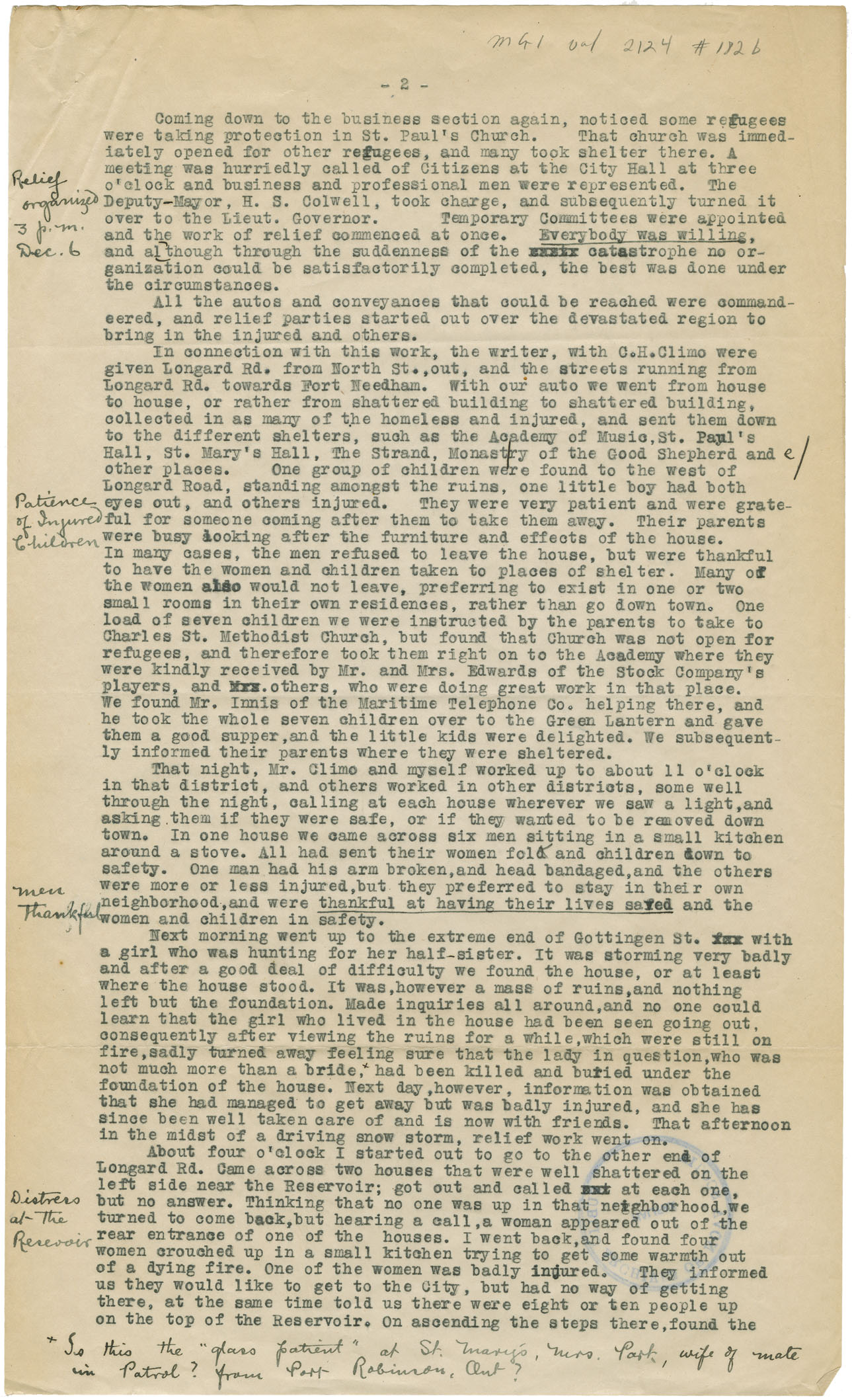Nova Scotia Archives
Archibald MacMechan
Halifax Disaster Record Office Materials
Personal narrative - Mr. W. A. Major
5 pages : 30 x 50 cm.
note: transcription publicly contributed - please contact us with comments, errors or omisions
MG 1 volume 2124 number 182b
- 2 -
Coming down to the business section again, noticed some refugees were taking protection in St. Paul's Church. That church was immediately opened for other refugees, and many took shelter there. A. meeting was hurriedly called of Citizens at the City Hall at three o'clock and business and professional men were represented. The Deputy-Mayor, H. S. Colwell, took charge, and subsequently turned it over to the Lieut. Governor. Temporary Committees were appointed and the work of relief commenced at once. Everybody was willing, and although through the suddenness of the [xxxxx] catastrophe no organization could be satisfactorily completed, the best was done under the circumstances.
All the autos and conveyances that could be reached were commandeered, and relief parties started out over the devastated region to bring in the injured and others.
In connection with this work, the writer, with C.H. Climo were given Longard Rd. from North St., out, and the streets running from Longard Rd. towards Fort Needham. With our auto we went from house to house, or rather from shattered building to shattered building, collected in as many of the homeless and injured, and sent them down to the different shelters, such as the Academy of Music, St. Paul's Hall, St. Mary's Hall, The Strand, Monastry of the Good Shepherd and other places. One group of children were found to the west of Longard Road, standing amongst the ruins, one little boy had both eyes out, and others injured. They were very patient and were grateful for someone coming after them to take them away. Their parents were busy looking after the furniture and effects of the house. In many cases, the men refused to leave the house, but were thankful to have the women and children taken to places of shelter. Many of the women also would not leave, preferring to exist in one or two small rooms in their own residences, rather than go down town. One load of seven children we were instructed by the parents to take to Charles St. Methodist Church, but found that Church was not open for refugees, and therefore took them right on to the Academy where they were kindly received by Mr. and Mrs. Edwards of the Stock Company's players, and [xxx] others, who were doing great work in that place. We found Mr. Innis of the Maritime Telephone Co. helping there, and he took the whole seven children over to the Green Lantern and gave them a good supper, and the little kids were delighted. We subsequently informed their parents where they were sheltered.
That night, Mr. Climo and myself worked up to about 11 o'clock in that district, and others worked in other districts, some well through the night, calling at each house wherever we saw a light, and asking them if they were safe, or if they wanted to be removed down town. In one house we came across six men sitting in a small kitchen around a stove. All had sent their women folk and children down to safety. One man had his arm broken and head bandaged, and the others were more or less injured, but they preferred to stay in their own neighborhood, and were thankful at having their lives saved and the women and children in safety.
Next morning went up to the extreme end of Gottingen St. [xxx] with a girl who was hunting for her half-sister. It was storming very badly and after a good deal of difficulty we found the house, or at least where the house stood. It was, however a mass of ruins and nothing left but the foundation. Made inquiries all around and no one could learn that the girl who lived in the house had been seen going out, consequently after viewing the ruins for a while, which were still on fire, sadly turned away feeling sure that the lady in question, who was not much more than a bride, had been killed and buried under the foundation of the house. Next day, however, information was obtained that she had managed to get away but was badly injured, and she has since been well taken care of and is now with friends. That afternoon in the midst of a driving snow storm relief work went on.
About four o'clock I started out to go to the other end of Longard Rd. Came across two houses that were well shattered on the left side near the Reservoir; got out and called [xxx] at each one, turned to come back, but hearing a call, a woman appeared out of the rear entrance of one of the houses. I went back, and found four women crouched up in a small kitchen trying to get some warmth out of a dying fire. One of the women was badly injured. They informed us they would like to get to the City, but had no way of getting there, at the same time told us there were eight or ten people up on the top of the Reservoir. On ascending the steps there, found the
x Is this the "glass patient" at St. Mary's, Mrs. Park, wife of mate in Patrol? from Port Robinson, Ont? [handwritten at the bottom of the page]
Relief organized 3 p.m. Dec. 6 [written in the left margin beside first paragraph]
Patience of Injured Children [written in left margin beside third paragraph]
Men Thankful [written in left margin at bottom of fourth paragraph]
Distress at the Resevoir [written in left margin beside last paragraph]
States the case of Annie Campbell, also typed account 29 December 1917, by W. A. Major.
Reference: Archibald MacMechan Nova Scotia Archives MG 1 volume 2124 number 182

